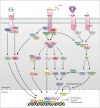Regulation of Osteoclast Differentiation by Cytokine Networks
- PMID: 29503739
- PMCID: PMC5833125
- DOI: 10.4110/in.2018.18.e8
Regulation of Osteoclast Differentiation by Cytokine Networks
Abstract
Cytokines play a pivotal role in maintaining bone homeostasis. Osteoclasts (OCs), the sole bone resorbing cells, are regulated by numerous cytokines. Macrophage colony-stimulating factor and receptor activator of NF-κB ligand play a central role in OC differentiation, which is also termed osteoclastogenesis. Osteoclastogenic cytokines, including tumor necrosis factor-α, IL-1, IL-6, IL-7, IL-8, IL-11, IL-15, IL-17, IL-23, and IL-34, promote OC differentiation, whereas anti-osteoclastogenic cytokines, including interferon (IFN)-α, IFN-β, IFN-γ, IL-3, IL-4, IL-10, IL-12, IL-27, and IL-33, downregulate OC differentiation. Therefore, dynamic regulation of osteoclastogenic and anti-osteoclastogenic cytokines is important in maintaining the balance between bone-resorbing OCs and bone-forming osteoblasts (OBs), which eventually affects bone integrity. This review outlines the osteoclastogenic and anti-osteoclastogenic properties of cytokines with regard to osteoimmunology, and summarizes our current understanding of the roles these cytokines play in osteoclastogenesis.
Keywords: Cytokines; Osteoclast differentiation factor; Osteoclastogenesis; Osteoimmunology.
Conflict of interest statement
Conflict of Interest: The authors declare no potential conflicts of interest.
Figures


Similar articles
-
IL-1β promotes osteoclastogenesis by increasing the expression of IGF2 and chemokines in non-osteoclastic cells.J Pharmacol Sci. 2023 Jan;151(1):1-8. doi: 10.1016/j.jphs.2022.10.007. Epub 2022 Oct 21. J Pharmacol Sci. 2023. PMID: 36522118
-
NF-kappaB p50 and p52 expression is not required for RANK-expressing osteoclast progenitor formation but is essential for RANK- and cytokine-mediated osteoclastogenesis.J Bone Miner Res. 2002 Jul;17(7):1200-10. doi: 10.1359/jbmr.2002.17.7.1200. J Bone Miner Res. 2002. PMID: 12096833
-
Chronological differential effects of pro-inflammatory cytokines on RANKL-induced osteoclast differentiation of canine bone marrow-derived macrophages.J Vet Med Sci. 2017 Dec 22;79(12):2030-2035. doi: 10.1292/jvms.17-0393. Epub 2017 Nov 3. J Vet Med Sci. 2017. PMID: 29109351 Free PMC article.
-
Involvement of receptor activator of NFkappaB ligand and tumor necrosis factor-alpha in bone destruction in rheumatoid arthritis.Bone. 2002 Feb;30(2):340-6. doi: 10.1016/s8756-3282(01)00682-2. Bone. 2002. PMID: 11856640 Review.
-
The mechanism of osteoclast differentiation from macrophages: possible roles of T lymphocytes in osteoclastogenesis.J Bone Miner Metab. 2003;21(6):337-43. doi: 10.1007/s00774-003-0439-1. J Bone Miner Metab. 2003. PMID: 14586789 Review.
Cited by
-
Chronic lymphocytic leukemia cells impair osteoblastogenesis and promote osteoclastogenesis: role of TNFα, IL-6 and IL-11 cytokines.Haematologica. 2021 Oct 1;106(10):2598-2612. doi: 10.3324/haematol.2019.231456. Haematologica. 2021. PMID: 32855274 Free PMC article.
-
Mechanistic Insights and Therapeutic Strategies in Osteoporosis: A Comprehensive Review.Biomedicines. 2024 Jul 23;12(8):1635. doi: 10.3390/biomedicines12081635. Biomedicines. 2024. PMID: 39200100 Free PMC article. Review.
-
Surface Pre-Reacted Glass-Ionomer Eluate Suppresses Osteoclastogenesis through Downregulation of the MAPK Signaling Pathway.Biomedicines. 2024 Aug 12;12(8):1835. doi: 10.3390/biomedicines12081835. Biomedicines. 2024. PMID: 39200299 Free PMC article.
-
Hedgehog Signaling Inhibition by Smoothened Antagonist BMS-833923 Reduces Osteoblast Differentiation and Ectopic Bone Formation of Human Skeletal (Mesenchymal) Stem Cells.Stem Cells Int. 2019 Nov 21;2019:3435901. doi: 10.1155/2019/3435901. eCollection 2019. Stem Cells Int. 2019. PMID: 31871467 Free PMC article.
-
PKCθ Regulates Pituitary Adenoma Bone Invasion by Activating Osteoclast in NF-κB/IL-1β-Dependent Manner.Cancers (Basel). 2023 Mar 6;15(5):1624. doi: 10.3390/cancers15051624. Cancers (Basel). 2023. PMID: 36900414 Free PMC article.
References
-
- Rho J, Takami M, Choi Y. Osteoimmunology: interactions of the immune and skeletal systems. Mol Cells. 2004;17:1–9. - PubMed
-
- Takayanagi H. Osteoimmunology: shared mechanisms and crosstalk between the immune and bone systems. Nat Rev Immunol. 2007;7:292–304. - PubMed
-
- Walsh MC, Kim N, Kadono Y, Rho J, Lee SY, Lorenzo J, Choi Y. Osteoimmunology: interplay between the immune system and bone metabolism. Annu Rev Immunol. 2006;24:33–63. - PubMed
Publication types
LinkOut - more resources
Full Text Sources
Other Literature Sources

